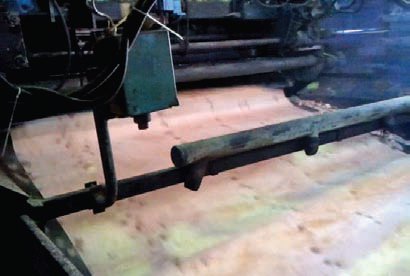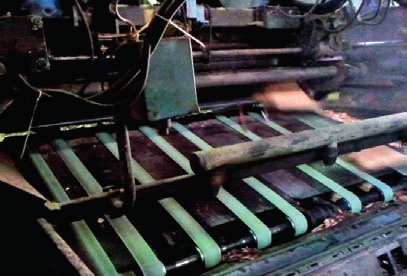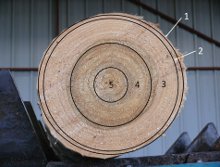In the zone
28 January 2015The manufacture of plywood requires large sheets of veneer. A typical panel is 2.44 x 1.22m (8 x 4ft), with the face veneer grain direction parallel to the longest edge of the panel. Such a structure requires veneers that are cut from logs, or more correctly bolts, that are more than 2.44m long for the faces and 1.22m long for the inner cross veneers.
The veneers are cut by peeling the bolts; similar to peeling the skin from an apple. The bolt is normally debarked and often, but not always, heated, to soften the wood, thus making it easier to peel. Debarking is necessary because the bolt often contains stones and sand which could easily damage the delicate knife in the peeling lathe.
The ideal for a plywood manufacturer is to cut a continuous ribbon of veneer from the bolt. He can then cut the ribbon into sheets appropriate for the size of panels he wishes to make. It is not possible to immediately cut a continuous ribbon because bolts almost never have a circular cross-section. In fact, they are often elliptical and are sometimes scarred or have growths; consequently, a continuous ribbon can only be formed once the bolt is truly rounded.
Figure 1 shows a photograph of the end of a poplar log just before it was peeled to veneer. I have superimposed some circles to help you visualise the main steps of peeling. The log is far from being perfectly round and so when it first contacts the knife the parts that are most proud are gradually removed with each turn of the log. The pieces that are generated in this period are waste (see Zone 1 of Figure 2) and are usually used as fuel. They are sometimes known as roundings or tailings. In Zone 2 the log is almost round, but not quite and so the veneer has holes in it. This veneer can be clipped with a guillotine to form strips of veneer that can be jointed together and used as an internal ply in a panel. The jointing does not reduce the strength properties of the panel because wood itself is very weak perpendicular to the grain.
Eventually the log is rounded and a continuous ribbon of veneer is cut. The quality of veneer changes as the bolt diameter is reduced. Initially, the veneer is clear, ie knot-free, and this veneer can be used for the faces of a plywood panel. Further into the bolt, knots tend to be more frequent as the tree was much younger, and therefore shorter, so the wood was formed near the crown, where the branches are. The knottier veneer can be used as face veneers for lower quality plywoods or for the inner veneers.
The spindle left at the end of peeling is often further processed by sawing into components for packaging, eg load bearers.
If the logs are circular with large diameters then maybe 80% of the log is converted to usable veneer. As diameter falls and form deviates from the round, then yield drops. Typical commercial yields are around 60-70%. During a recent visit to a mill, I discovered that the manufacturer was making more money selling his wastes to the energy sector than using them himself for energy. How times are changing.


